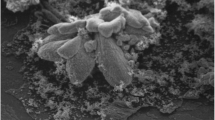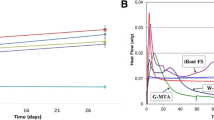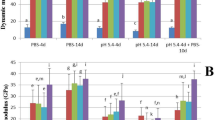Abstract
Objectives
The aims of this study were to evaluate the radiopacity, compressive strength, setting time, and porosity of white Portland cement (PC) with the addition of bismuth oxide (Bi2O3), zirconium dioxide (ZrO2), and ytterbium trifluoride (YbF3) after immersion at 37 °C for 7 days in distilled water or phosphate buffer saline.
Materials and methods
Specimens measuring 8 mm in diameter and 1 mm in thickness were fabricated from PC with the addition of 10, 20, and 30 wt% Bi2O3, ZrO2 or YbF3. ProRoot MTA (Dentsply, Tulsa, OK, USA) and pure PC were used as controls. For radiopacity assessments, specimens were radiographed alongside a tooth slices and an aluminum stepwedge on Extraspeed occlusal dental films (Insight Kodak, Rochester, New York). Mean optical density of each specimen was calculated and used to express radiopacity of the material as an equivalent thickness of aluminum. Compressive strength was measured by using 4-mm diameter and 6-mm high specimens and Universal testing machine. High-pressure mercury intrusion porosimeter (Carlo Erba Porosimeter 2000) was employed to measure the porosity of the specimens. The setting time was measured by using a needle of 100 g in weight. The morphology of specimens was evaluated using a scanning electron microscope (TESCAN Mira3 XMU, USA Inc.). Data were analyzed by one-way ANOVA and post hoc Tukey test (P < 0.05).
Results
The PC with the addition of at least 10 wt% Bi2O3 and 20 wt% ZrO2 or YbF3 demonstrated greater radiopacity value than the recommended 3 mmAl cut-off. ZrO2 and YbF3 increased the compressive strength of PC, but it was not statistically significant (P > 0.05), while Bi2O3 decreased it (P < 0.05). All radiopacifiers significantly increased the porosity of the experimental cements (P < 0.05). Bi2O3 extended the setting time of PC (P < 0.05), whilst ZrO2 and YbF3 did not significantly affect it (P > 0.05).
Conclusions
ZrO2 and YbF3 may be used as a suitable alternative to replace Bi2O3 in MTA without influencing its physical properties.





Similar content being viewed by others
References
Al-Kahtani A, Shostad S, Schifferle R, Bhambhani S (2005) In-vitro evaluation of microleakage of an orthograde apical plug of mineral trioxide aggregate in permanent teeth with simulated immature apices. J Endod 31:117–119
Unal GC, Maden M, Isidan T (2010) Repair of furcal iatrogenic perforation with mineral trioxide aggregate: two years follow-up of two cases. Eur J Dent 4:475–481
Lee SK, Lee SI, Park JH, Jang JH, Kim HW, Kim EC (2010) Effect of calcium phosphate cements on growth and odontoblastic differentiation in human dental pulp cells. J Endod 36:1537–1542
Karabucak B, Li D, Lim J, Iqbal M (2005) Vital pulp therapy with mineral trioxide aggregate. Dent Traumatol 21:240–243
Oliveira TM, Sakai VT, Silva TC, Santos CF, Abdo RC, Machado MA (2008) Mineral trioxide aggregate as an alternative treatment for intruded permanent teeth with root resorption and incomplete apex formation. Dent Traumatol 24:565–568
Estrela C, Bammann LL, Estrela CR, Silva RS, Pecora JD (2000) Antimicrobial and chemical study of MTA, Portland cement, calcium hydroxide paste, sealapex and dycal. Braz Dent J 11:3–9
Torabinejad MWT, Pitt Ford TR (1993) Sealing ability of an MTA when used as a root end filling material. J Endod 19:591–595
Fridland M, Rosado R (2005) MTA solubility: a long term study. J Endod 31:376–379
Menezes R, Bramante CM, Letra A, Carvalho VG, Garcia RB (2004) Histologic evaluation of pulpotomies in dog using two types of mineral trioxide aggregate and regular and white Portland cements as wound dressings. Oral Surg Oral Med Oral Pathol Oral Radiol Endod 98:376–379
De-Deus G, Reis C, Brandao C, Fidel S, Fidel RA (2007) The ability of Portland cement, MTA, and MTA Bio to prevent through-and-through fluid movement in repaired furcal perforations. J Endod 33:1374–1377
Camilleri J, Gandolfi MG (2010) Evaluation of the radiopacity of calcium silicate cements containing different radiopacifiers. Int Endod J 43:21–30
Islam I, Chng HK, Yap AU (2006) Comparison of the physical and mechanical properties of MTA and Portland cement. J Endod 32:193–197
Camilleri J (2008) Characterization of hydration products of mineral trioxide aggregate. Int Endod J 41:408–417
Camilleri J (2008) The physical properties of accelerated Portland cement for endodontic use. Int Endod J 41:151–157
Camilleri J (2007) Hydration mechanisms of mineral trioxide aggregate. Int Endod J 40:462–470
Laustsen MH, Munksgaard EC, Reit C, Bjorndal L (2005) A temporary filling material may cause cusp deflection, infractions and fractures in endodontically treated teeth. Int Endod J 38:653–657
Lide DR (1998) CRC handbook of chemistry and physics, 79th edn. CRC Press, Taylor & Francis, Abingdon, pp 1–10
Coomaraswamy KS, Lumley PJ, Hofmann MP (2007) Effect of bismuth oxide radioopacifier content on the material properties of an endodontic Portland cement-based (MTA-like) system. J Endod 33:295–298
Bortoluzzi EA, Guerreiro-Tanomaru JM, Tanomaru-Filho M, Duarte MA (2009) Radiographic effect of different radiopacifiers on a potential retrograde filling material. Oral Surg Oral Med Oral Pathol Oral Radiol Endod 108:628–632
Hungaro Duarte MA, de Oliveira El Kadre GD, Vivan RR, Guerreiro Tanomaru JM, Tanomaru Filho M, de Moraes IG (2009) Radiopacity of Portland cement associated with different radiopacifying agents. J Endod 35:737–740
Parirokh M, Torabinejad M (2010) Mineral trioxide aggregate: a comprehensive literature review—part I: chemical, physical, and antibacterial properties. J Endod 36:16–27
Camilleri J, Cutajar A, Mallia B (2011) Hydration characteristics of zirconium oxide replaced Portland cement for use as a root-end filling material. Dent Mater 27:845–854
Cutajar A, Mallia B, Abela S, Camilleri J (2011) Replacement of radiopacifier in mineral trioxide aggregate; characterization and determination of physical properties. Dent Mater 27:879–891
Grech L, Mallia B, Camilleri J (2013) Characterization of set intermediate restorative material, biodentine, bioaggregate and a prototype calcium silicate cement for use as root-end filling materials. Int Endod J 46:632–641
Kim EC, Lee BC, Chang HS, Lee W, Hong CU, Min KS (2008) Evaluation of the radiopacity and cytotoxicity of Portland cements containing bismuth oxide. Oral Surg Oral Med Oral Pathol Oral Radiol Endod 105:e54–e57
Saliba E, Abbassi-Ghadi S, Vowles R, Camilleri J, Hooper S (2009) Evaluation of the strength and radiopacity of Portland cement with varying additions of bismuth oxide. Int Endod J 42:322–328
Vivan RR, Ordinola-Zapata R, Bramante CM, Bernardineli N, Garcia RB, Hungaro Duarte MA, de Moraes IG (2009) Evaluation of the radiopacity of some commercial and experimental root-end filling materials. Oral Surg Oral Med Oral Pathol Oral Radiol Endod 108:e35–e38
Hwang YC, Lee SH, Hwang IN, Kang IC, Kim MS, Kim SH, Son HH, Oh WM (2009) Chemical composition, radiopacity, and biocompatibility of Portland cement with bismuth oxide. Oral Surg Oral Med Oral Pathol Oral Radiol Endod 107:e96–e102
Coomaraswamy KS, Lumney LP, Hofmann MP (2008) Effect of cement paste dilution on the radiopacity of MTA, abstract 0613. Pan European Federation for Dental Research, London
Watts DC, McCabe JF (1999) Aluminium radiopacity standards for dentistry: an international survey. J Dent 27:73–78
Kogan P, He J, Glickman GN, Watanabe I (2006) The effects of various additives on setting properties of MTA. J Endod 32:569–572
Ber BS, Hatton JF, Stewart GP (2007) Chemical modification of proroot MTA to improve handling characteristics and decrease setting time. J Endod 33:1231–1234
Hwang YC, Kim DH, Hwang IN, Song SJ, Park YJ, Koh JT, Son HH, Oh WM (2011) Chemical constitution, physical properties, and biocompatibility of experimentally manufactured Portland cement. J Endod 37:58–62
International Organization for Standardization (2001) Specification for dental root canal sealing materials. ISO 6876, Geneva
du Sart GG, Vukovic I, Vukovic Z, Polushkin E, Hiekkataipale P, Ruokolainen J, Loos K, ten Brinke G (2011) Nanoporous network channels from self-assembled triblock copolymer supramolecules. Macromol Rapid Commun 32:366–370
Milutinović-Nikolić AD, Medić VB, Vuković ZM (2007) Porosity of different dental luting cements. Dent Mater 23:674–678
Acknowledgments
This work was supported by the Ministry of Education and Science of the Republic of Serbia (projects no. III 45001 and III 45005).
Conflict of interest
The authors declare no conflict of interest.
Author information
Authors and Affiliations
Corresponding author
Rights and permissions
About this article
Cite this article
Antonijevic, D., Medigovic, I., Zrilic, M. et al. The influence of different radiopacifying agents on the radiopacity, compressive strength, setting time, and porosity of Portland cement. Clin Oral Invest 18, 1597–1604 (2014). https://doi.org/10.1007/s00784-013-1130-0
Received:
Accepted:
Published:
Issue Date:
DOI: https://doi.org/10.1007/s00784-013-1130-0




